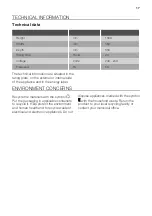
OK
OK
A
B
After putting fresh food into the
appliance or after opening the
door repeatedly or for a long
period, it is normal for the
indicator not to show "OK"; wait
at least 12 hours before
readjusting the temperature
controller.
Ice-cube production
This appliance is equipped with one or
more trays for the production of ice-cubes.
Do not use metallic instruments
to remove the trays from the
freezer.
1.
Fill these trays with water
2.
Put the ice trays in the freezer
compartment.
Thawing
Deep-frozen or frozen food, prior to being
used, can be thawed in the refrigerator
compartment or at room temperature,
depending on the time available for this
operation.
Small pieces may even be cooked still
frozen, directly from the freezer: in this
case, cooking will take longer.
HINTS AND TIPS
Normal operating sounds
The following sounds are normal during
operation:
• A faint gurgling and bubbling sound from
coils sound when refrigerant is pumped.
• A whirring and pulsating sound from the
compressor when refrigerant is pumped.
• A sudden cracking noise from inside
appliance caused by thermic dilatation (a
natural and not dangerous physical
phenomenon).
• A faint click noise from the temperature
regulator when the compressor switches
on or off.
Hints for energy saving
• Do not open the door frequently or leave
it open longer than absolutely necessary.
Hints for fresh food refrigeration
To obtain the best performance:
• do not store warm food or evaporating
liquids in the refrigerator
• do cover or wrap the food, particularly if
it has a strong flavour
• position food so that air can circulate
freely around it
Hints for refrigeration
Useful hints:
• Meat (all types) : wrap in polythene bags
and place on the glass shelf above the
vegetable drawer.
• For safety, store in this way only one or
two days at the most.
• Cooked foods, cold dishes, etc. : these
should be covered and may be placed
on any shelf.
• Fruit and vegetables: these should be
thoroughly cleaned and placed in the
special drawer(s) provided.
• Butter and cheese: these should be
placed in special airtight containers or
wrapped in aluminium foil or polythene
bags to exclude as much air as possible.
• Bottles: these need a cap and should be
stored on the door bottle shelf, or (if
equipped) on the bottle rack.
• Bananas, potatoes, onions and garlic, if
not packed, must not be kept in the
refrigerator.
7



































